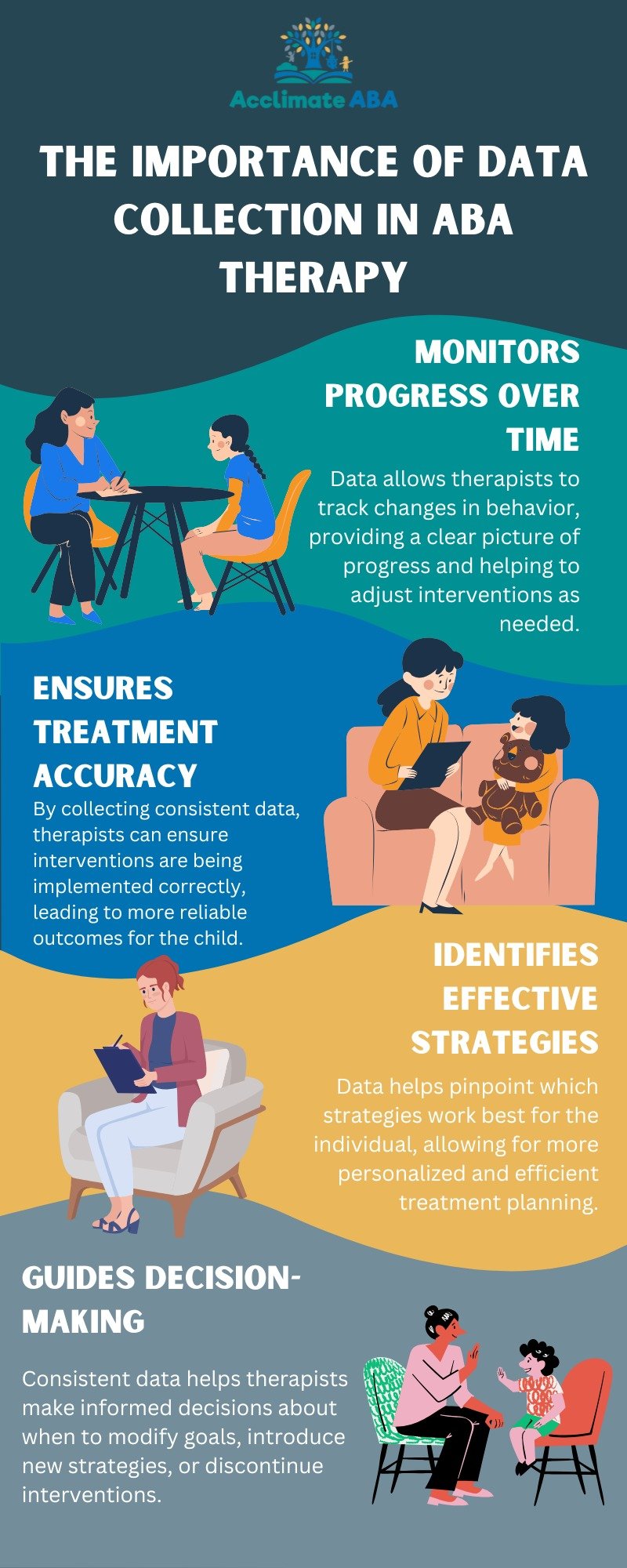Key Points:
- Data collection in ABA is essential for measuring progress, identifying patterns, and tailoring behavior plans effectively.
- Different data recording methods are used depending on the behavior type and goals of therapy.
- Choosing the right data collection system improves accuracy and supports long-term success.
Applied Behavior Analysis (ABA) is a science-driven approach, and at its core lies data. In fact, data collection in ABA is the backbone of effective therapy. It provides the information needed to make decisions, track a child’s progress, and determine whether an intervention is working.
Without solid data, therapists and families are left to guess, which can lead to ineffective strategies or missed milestones. This article breaks down the most widely used ABA data collection methods in practical, parent-friendly terms.
What is Data Collection in ABA?
Data collection in ABA refers to systematically recording behavior to understand patterns, track changes, and guide therapy decisions. This process is essential in ABA therapy. It allows behavior analysts to objectively assess whether a child is learning a new skill, reducing a problem behavior, or maintaining progress.
Accurate behavior tracking provides measurable evidence that helps therapists adjust teaching methods and interventions to better meet the child’s needs. There are several methods used depending on the behavior being targeted, how often it occurs, and the type of data needed. To learn more about how these approaches play out in real group settings and what families can anticipate, check out our detailed guide What to Expect When Your Child Joins a Group Therapy for Autism.
What are the Different Data Collection Types in ABA Therapy?
In Applied Behavior Analysis (ABA) therapy, data collection is a critical component for tracking progress and making informed decisions about treatment. Accurate data allows therapists to assess the effectiveness of interventions, understand behavior patterns, and adjust strategies as needed.
There are several types of data collection methods used in ABA, each designed to capture specific aspects of behavior, such as frequency, duration, and intensity. These methods provide valuable insights into how behaviors change over time and help guide treatment decisions.
Let’s explore the different types of data collection commonly used in ABA therapy:
1. Frequency/Event Recording
When a behavior is discrete (clearly defined with a beginning and end) and occurs multiple times during a session, frequency recording is a go-to method. It simply involves counting how many times a behavior occurs within a specific timeframe.
For example, how many times a child hits, raises their hand, or says “please” in 30 minutes. This is ideal for behaviors that don’t last long and happen often.
Best used for:
- Requests (mands)
- Aggression
- Tantrums
- Task initiation
2. Duration Recording
Not all behaviors can or should be counted. Some are better measured by how long they last. That’s where duration recording comes in. It tracks the total time a behavior occurs within a session or a specific timeframe.
This method helps determine whether a child is improving in attention span, reducing time spent engaging in problem behavior, or increasing time on task.
Common use cases include:
- Time spent engaging in self-stimulatory behavior
- Task engagement (e.g., time spent reading or writing)
- Screaming or crying episodes
3. Latency Recording
Latency is the time between a given instruction and when the child begins the targeted behavior. Latency recording is used to see how quickly (or slowly) a child responds to prompts or requests.
This is particularly important when assessing processing speed, motivation, or compliance.
Why it matters:
- Measures responsiveness
- Identifies prompt dependency or hesitation
- Helps adjust the level of support provided
4. Interval Recording
Interval recording divides an observation period into smaller, equal segments and notes whether a behavior occurs during each one. It doesn’t count how many times the behavior happens, just whether it happens at all in that window.
The first type, Partial-interval recording, marks the behavior as occurring if it happens at any point during the interval. Meanwhile, Whole-interval recording marks the behavior only if it occurs for the entire duration of the interval. This method is useful when it’s difficult to count every occurrence or when estimating overall behavior patterns is more relevant than exact numbers.
Best for:
- Monitoring off-task behavior
- Tracking classroom participation
- Evaluating sustained attention
5. Momentary Time Sampling
This method also uses intervals, but instead of observing for the full interval, you only check at the exact moment each interval ends.
For example, in a 10-minute session with 1-minute intervals, the observer would look up every minute and note whether the behavior is occurring right at that moment.
Benefits include:
- Less time-intensive for staff
- Ideal for group settings or classrooms
- Useful when continuous observation isn’t feasible
6. Permanent Product Recording
In some cases, you don’t need to watch the behavior happen at all—you can measure its outcome. This is called permanent product data collection. It tracks the physical results of a behavior. This method is especially useful for tasks that result in something observable and countable after the fact.
For example:
- Number of worksheets completed
- Dishes cleaned
- Toys picked up after playtime
7. ABC (Antecedent-Behavior-Consequence) Data
ABC data collection is used for understanding why a behavior occurs. It’s a more narrative form of data that documents. This method is often used during functional behavior assessments to discover behavior triggers and identify patterns:
- Antecedent: What happened right before the behavior
- Behavior: What the behavior looked like
- Consequence: What happened immediately after
Helps identify:
- Environmental factors leading to problem behavior
- Reinforcement unintentionally maintaining the behavior
- Effective replacement behaviors or interventions
Why Consistent Data Collection Matters in ABA
In ABA therapy, consistent data collection is essential to track progress, make informed decisions, and adjust treatment plans. Data helps therapists and families understand behavior patterns, assess the effectiveness of interventions, and ensure long-term success.
Here are key reasons why data collection is critical:
 Get Expert Support with ABA Therapy in Utah
Get Expert Support with ABA Therapy in Utah
Understanding how to use data collection in ABA is just the first step. Implementing it effectively requires expert guidance, consistent monitoring, and tailored support. At Acclimate ABA, we offer individualized ABA therapy in Utah to help support your child’s progress.
Our expert team is dedicated to helping children make measurable, lasting progress. We use proven data collection systems to guide each decision and involve parents every step of the way. Whether you’re seeking help with reducing problem behavior, teaching life skills, or supporting social development, our data-focused ABA programs ensure that every step is backed by evidence—and built for success.
Contact us today to learn how we can support your child’s progress through thoughtful, effective ABA therapy in Utah.


